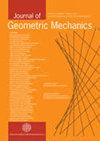Constrained systems, generalized Hamilton-Jacobi actions, and quantization
IF 1
4区 数学
Q3 MATHEMATICS, APPLIED
引用次数: 6
Abstract
Mechanical systems (i.e., one-dimensional field theories) with constraints are the focus of this paper. In the classical theory, systems with infinite-dimensional targets are considered as well (this then encompasses also higher-dimensional field theories in the hamiltonian formalism). The properties of the Hamilton–Jacobi (HJ) action are described in details and several examples are explicitly computed (including nonabelian Chern–Simons theory, where the HJ action turns out to be the gauged Wess–Zumino–Witten action). Perturbative quantization, limited in this note to finite-dimensional targets, is performed in the framework of the Batalin–Vilkovisky (BV) formalism in the bulk and of the Batalin–Fradkin–Vilkovisky (BFV) formalism at the endpoints. As a sanity check of the method, it is proved that the semiclassical contribution of the physical part of the evolution operator is still given by the HJ action. Several examples are computed explicitly. In particular, it is shown that the toy model for nonabelian Chern–Simons theory and the toy model for 7D Chern–Simons theory with nonlinear Hitchin polarization do not have quantum corrections in the physical part (the extension of these results to the actual cases is discussed in the companion paper [21]). Background material for both the classical part (symplectic geometry, generalized generating functions, HJ actions, and the extension of these concepts to infinite-dimensional manifolds) and the quantum part (BV-BFV formalism) is provided.约束系统,广义Hamilton-Jacobi作用,和量化
具有约束的机械系统(即一维场论)是本文的重点。在经典理论中,也考虑了具有无限维目标的系统(这也包括了哈密顿形式主义中的高维场论)。详细描述了Hamilton-Jacobi (HJ)作用的性质,并明确地计算了几个例子(包括非阿贝尔的chen - simons理论,其中HJ作用被证明是测量的Wess-Zumino-Witten作用)。微扰量化,在本笔记中仅限于有限维目标,在主体和端点的Batalin-Fradkin-Vilkovisky (BFV)形式主义框架内进行。作为该方法的完整性检验,证明了演化算子的物理部分的半经典贡献仍然由HJ作用给出。明确地计算了几个例子。特别地,证明了非阿贝尔Chern-Simons理论的玩具模型和具有非线性Hitchin极化的7D Chern-Simons理论的玩具模型在物理部分不具有量子修正(将这些结果推广到实际情况的讨论在伴文[21]中)。提供了经典部分(辛几何,广义生成函数,HJ作用,以及将这些概念扩展到无限维流形)和量子部分(BV-BFV形式主义)的背景材料。
本文章由计算机程序翻译,如有差异,请以英文原文为准。
求助全文
约1分钟内获得全文
求助全文
来源期刊

Journal of Geometric Mechanics
MATHEMATICS, APPLIED-PHYSICS, MATHEMATICAL
CiteScore
1.70
自引率
12.50%
发文量
23
审稿时长
>12 weeks
期刊介绍:
The Journal of Geometric Mechanics (JGM) aims to publish research articles devoted to geometric methods (in a broad sense) in mechanics and control theory, and intends to facilitate interaction between theory and applications. Advances in the following topics are welcomed by the journal:
1. Lagrangian and Hamiltonian mechanics
2. Symplectic and Poisson geometry and their applications to mechanics
3. Geometric and optimal control theory
4. Geometric and variational integration
5. Geometry of stochastic systems
6. Geometric methods in dynamical systems
7. Continuum mechanics
8. Classical field theory
9. Fluid mechanics
10. Infinite-dimensional dynamical systems
11. Quantum mechanics and quantum information theory
12. Applications in physics, technology, engineering and the biological sciences.
 求助内容:
求助内容: 应助结果提醒方式:
应助结果提醒方式:


